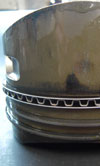Securing piston life
 Getting long life from a racing piston that is subjected to 8000 hp is not easy. Every trip down the 1000-foot dragstrip used by NHRA's Full Throttle Drag Racing Series means a modicum of damage to an engine and, with the pistons, damage is a way of life.
Getting long life from a racing piston that is subjected to 8000 hp is not easy. Every trip down the 1000-foot dragstrip used by NHRA's Full Throttle Drag Racing Series means a modicum of damage to an engine and, with the pistons, damage is a way of life.
John Stewart, tuner and crew chief for sophomore Top Fuel racer Shawn Langdon, has a great deal of experience in the sport, which makes him a perfect choice to take care of a newcomer like Langdon. "We use Venolia pistons with a triple ring," he says, made of billet aluminium, "the same everybody else runs.
"We find the most wear occurs on the skirt, because the piston rocks around and puts a hole out. It'll just scuff the backside of the piston a little bit, putting a little mark there and a little light gristle on the gut. It gets to the skirt and starts dancing around, and once that is done - when [the engine] hits the rev limiter or when he's shutting off at the other end (of the track) - it takes all the fuel away, but we're still trying to run, so it scores the skirt," Stewart explains.
Stewart checks his pistons for dish after every run. "They'll run for a while but I don't like to put more than 12 runs on them," he says. "As long as they check out, I'll go forever, but you really have to watch them. Sometimes they start breaking the ring lands, and I'll start chipping that away."
After each run this tuner/crew chief will pull the pistons and check them. "As long as they're free, they're okay and I'll leave them in the rack. The 'kid' (who cleans up the engine parts) will go through and check them all. And as long as they're good we'll keep running them."
Scoring is normal wear and tear on a Top Fuel piston, and Stewart's team takes that condition in stock for its wear checks.
Stewart uses three piston heights. "We run the setback blower with a little opening on the front of the manifold, so the piston in the front has to be a lower piston," he says. "You can't run as much compression because that air is coming straight down on numbers 1 and 2. [Numbers] 7 and 8 are in the back and they are a little bit taller. Seven is taller.
"We use three different heights. [Pistons] One and 2 are the same, while 7 is a little bit taller because it doesn't get the air, so I run more compression there. Number 5 is a little bit lower because it is right in the middle of the block," he says.
Stewart admitted that piston numbers 1 and 2 see the most damage, as well as number 7, because that is where the air is lacking in the engine. "It's all about the way the motor is fed the air," he says. "Those are the ones that tend to get picked on - 1, 2 and 7."
Normal service life for Top Fuel pistons can't really be defined because of the nature of each race. "We'll bring them in and put them up on the rack, go around with the gauge and check the tops for dish. If they are dished more than five thousandths I won't run them again, they'll sag," Stewart says. .
"I finally got my motor to work the way I want, so I haven't been hurting the pistons that much," he's pleased to say. "And that Shawn Langdon is a real driving machine!"
Fig. 1 - Morgan Lucas racing piston
Written by Anne Proffit